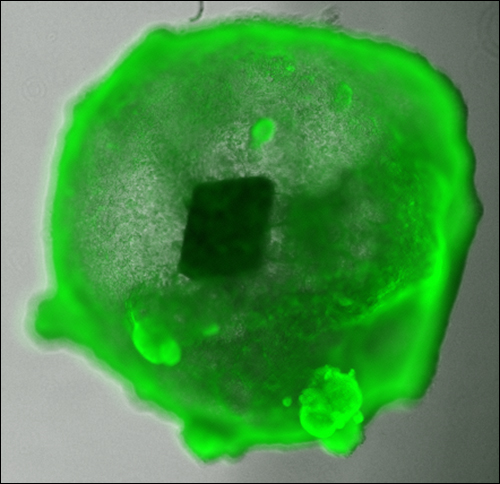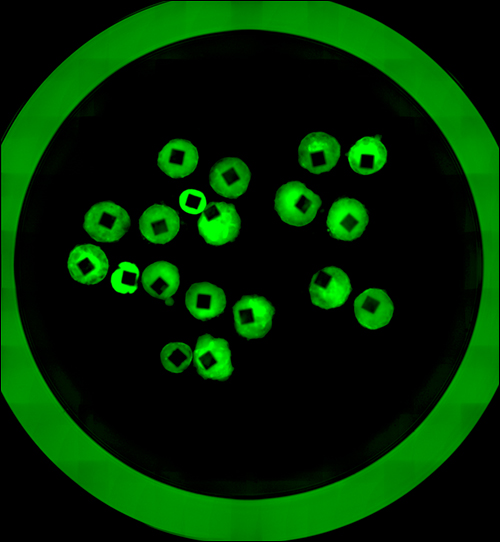Jun 07, 2018While RFID chips are more typically applied to packaging or containers of goods, or to materials being racked, a team of researchers has developed a system in which an RFID tag is part of a human organoid, with the tissue grown directly around the chip. In that way, the tag can always be uniquely identified, no matter what plate or dish it's stored in.
The researchers, working at Cincinnati Children's Hospital Medical Center, have developed a system known as RFID integrated Organoid (RiO) to automatically identify human organoids in groups as they are used in lab experiments, to develop pharmaceutical products or for implants. The work is being led by Takanori Takebe, a clinician and researcher at the medical center, as well as at the Tokyo Medical and Dental University, and Yokohama City University.

Organoids are miniature human organs produced from stem cells in a lab to be used for experimentation purposes. With the live tissue, scientists can test how organs from humans of a variety of backgrounds respond to medications, or in various environments, in order to ensure that a drug or implant would be safe with all kinds of patients. Organoids are still fairly new—they evolved rapidly several years ago—and are awaiting clinical applications, but there are limited numbers of them. "They have tremendous promise for medical applications," says Takebe, "but there are limits in scalability."
Each organoid must be grown from stem cells, which takes several weeks, and the cost of the process, along with the relatively limited access to the stem cells needed, means that they can't be provided in the volume that pharmaceutical companies and researchers might want for large-scale testing. That means each organoid would serve the scientific community best, Takebe says, if it could be used multiple times, through a variety of tests—and in a pool within a single well, rather than each in its own unique container. "By pooling the organoids in the same well," he states, "significant cost reduction will be expected, besides enhanced reproducibility of the experiments."
Since RFID is typically attached as an exterior tag or label, Takebe says, implanting an RFID chip into human tissue posed the greatest challenge. The scientists couldn't risk damaging an organoid by inserting the chip into it. So instead, the RFID chip was introduced at the earliest of organoid development.
The small organs are created through what Takebe calls a self-assembly process. Cells line up to build what he describes as a polarized structure that comes with a natural cavity. Therefore, the scientists introduced the RFID chips (which measure 0.4 millimeter) during that self-assembly process. The cells are then assembled around the chips. The chip comes with 512 bits of memory, Takebe says, so that data beyond a unique ID could be stored on it.
Once the organoids are fully assembled around the RFID chip (the growth of the organoid still takes about two weeks) the chip's unique ID number is paired with information about the tissue donor, such as phenotype features that could be used as markers during testing. The organoids are then placed in dishes in groups (each fits into a compartment within the tray or well), so that testing can be accomplished on multiple specimens at once. The wells with the organoids are then referred to as a multi-donor derived RiO pool.
The proof-of-concept took place in the lab by testing the effectiveness of detecting the genetic disorder of steatohepatitis in the RFID-enabled tissues. For the testing, the scientists used a process of phenotypic screening on a group of 10 organoids. Some of the organoids came from healthy donors, while others were diseased.
The research team developed a device with a built-in RFID interrogator to simultaneously measure the fluorescence and detect the UHF RFID chip in a single step. The RiO pool was then placed on the counter-top interrogator that captured all of the tag IDs and their locations within the wells, at a very close range. A built-in microscope, at the same time, uses fluorescence to automatically identify the lipid accumulation (and thus the presence of steatohepatitis) in the tissues. The fluorescence intensity used and the morphology results were then pair with the chip's ID number.

In a typical testing environment, if a reading of interest was detected, the organoids would be automatically detected. In that way, the system could identify a disease and link that information to the small tissue that could then be reused in other testing.
In the case of the RiO pilot, the team evaluated whether the chip could in any way compromise the tissue inside which it was embedded. They found, in fact, that the chip had limited effect on the cells that assembled around it. They tested for bile transport capacity and fat accumulation capacity in the RiO, Takebe says, and found "that the presence of the RFID chip in the liver organoids does not seem to affect native structure and function." The researchers also tested the RFID chips in freezing and liquid nitrogen environments and found that they continued to operate properly.
The group has more testing ahead, Takebe notes, but the long-term goal is to commercialize a product that could be used by labs and pharmaceutical companies. The RFID technology built into the organoids could then help scientists better understand how certain conditions will affect organs in people with specific characteristics.
What the group found, Takebe says, is that "a RiO-based pooling approach will be an efficient way to determine individualized phenotypes in a high-throughput setting." He says he is in conversations with several pharmaceutical companies that would like to test the system with RFID chips, readers and software that can capture, manage and display the RFID read data together with test results.

